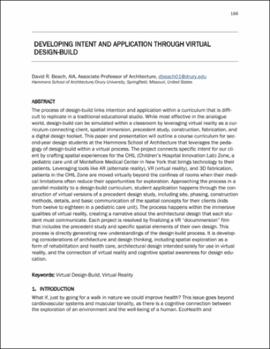| dc.contributor.author | Beach, David R. | |
| dc.date.accessioned | 2022-03-23T20:44:55Z | |
| dc.date.available | 2022-03-23T20:44:55Z | |
| dc.date.issued | 2022 | |
| dc.identifier.citation | Beach, David R., "Developing Intent and Application Through Virtual Design-Build," in Person, Angela M., Anthony Cricchio, and Stephanie Z. Pilat, eds. 2022. Proceedings of Schools of Thought: Rethinking Architectural Pedagogy, Norman, Oklahoma, March 5-7, 2020. University of Oklahoma Libraries: ShareOK. | |
| dc.identifier.uri | https://hdl.handle.net/11244/335066 | |
| dc.description | This paper was presented at the 2020 Schools of Thought Conference hosted by the Christopher C. Gibbs College of Architecture at the University of Oklahoma. | |
| dc.description.abstract | The process of design-build links intention and application within a curriculum that is difficult to replicate in a traditional educational studio. While most effective in the analogue world, design-build can be simulated within a classroom by leveraging virtual reality as a curriculum connecting client, spatial immersion, precedent study, construction, fabrication, and a digital design toolset. This paper and presentation will outline a course curriculum for second-year design students at the Hammons School of Architecture that leverages the pedagogy of design-build within a virtual process. The project connects specific intent for our client by crafting spatial experiences for the CHIL (Children’s Hospital Innovation Lab) Zone, a pediatric care unit of Montefiore Medical Center in New York that brings technology to their patients. Leveraging tools like AR (alternate reality), VR (virtual reality), and 3D fabrication, patients in the CHIL Zone are moved virtually beyond the confines of rooms when their medical limitations often reduce their opportunities for exploration. Approaching the process in a parallel modality to a design-build curriculum, student application happens through the construction of virtual versions of a precedent design study, including site, phasing, construction methods, details, and basic communication of the spatial concepts for their clients (kids from twelve to eighteen in a pediatric care unit). The process happens within the immersive qualities of virtual reality, creating a narrative about the architectural design that each student must communicate. Each project is resolved by finalizing a VR “docummersion” film that includes the precedent study and specific spatial elements of their own design. This process is directly generating new understandings of the design-build process. It is developing considerations of architecture and design thinking, including spatial exploration as a form of rehabilitation and health care, architectural design intended solely for use in virtual reality, and the connection of virtual reality and cognitive spatial awareness for design education. | |
| dc.language.iso | en_US | |
| dc.relation.ispartof | 2020 Schools of Thought Conference | |
| dc.relation.uri | https://hdl.handle.net/11244/335058 | |
| dc.rights | CC BY-NC-SA | |
| dc.rights.uri | https://creativecommons.org/licenses/by-nc-sa/4.0/ | |
| dc.subject | virtual design-build | |
| dc.subject | virtual reality | |
| dc.title | Developing Intent and Application Through Virtual Design-Build | |
| dc.type | Article | |
| dc.description.peerreview | Yes | |
| dc.identifier.doi | 10.15763/11244/335066 | |
| ou.group | Christopher C. Gibbs College of Architecture | |


